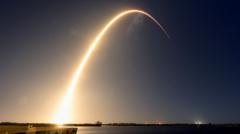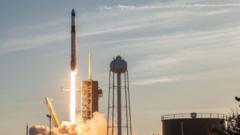**With new commercial missions underway, the lunar landscape is set for exploration by the next generation of technology and partnerships.**
**SpaceX Successfully Launches Two Private Lunar Landers on Rideshare Mission**

**SpaceX Successfully Launches Two Private Lunar Landers on Rideshare Mission**
**Innovative lunar exploration is advancing as SpaceX helps private companies reach the Moon.**
The Falcon 9 rocket, launched by SpaceX from Kennedy Space Center in Florida, has successfully embarked on a pioneering journey to the Moon, carrying lunar landers from private companies in the United States and Japan. Taking off at 01:09 local time (06:09 GMT) on Wednesday, the mission includes Firefly Aerospace's Blue Space rover and ispace's Resilience lander, both designed to operate autonomously once they reach lunar orbit.
The Blue Space rover is expected to take approximately 45 days to arrive at the Moon. After separating from the Falcon 9, it will engage in critical research activities, including drilling for samples and capturing X-ray data of Earth's magnetic field. Such initiatives aim to enhance our understanding of potential human missions to the lunar surface and the influences of space weather on Earth, according to information released by SpaceX.
On the other hand, ispace's Resilience lander is planned to descend to the lunar surface within a five-month timeframe. Upon landing, it will deploy a rover tasked with exploring the Moon and sampling the loose regolith that characterizes its terrain. This mission represents NASA's commitment to facilitating private sector involvement in lunar exploration, potentially marking its most significant commercial delivery to date.
This launch continues a trend of increasing private sector activity on the Moon, following last year's success of Intuitive Machines, which became the first commercial company to achieve a lunar landing. In a parallel development, SpaceX is preparing for its seventh orbital flight test of the Starship rocket, expected to launch from Texas later today at 16:00 local time (22:00 GMT).
The Blue Space rover is expected to take approximately 45 days to arrive at the Moon. After separating from the Falcon 9, it will engage in critical research activities, including drilling for samples and capturing X-ray data of Earth's magnetic field. Such initiatives aim to enhance our understanding of potential human missions to the lunar surface and the influences of space weather on Earth, according to information released by SpaceX.
On the other hand, ispace's Resilience lander is planned to descend to the lunar surface within a five-month timeframe. Upon landing, it will deploy a rover tasked with exploring the Moon and sampling the loose regolith that characterizes its terrain. This mission represents NASA's commitment to facilitating private sector involvement in lunar exploration, potentially marking its most significant commercial delivery to date.
This launch continues a trend of increasing private sector activity on the Moon, following last year's success of Intuitive Machines, which became the first commercial company to achieve a lunar landing. In a parallel development, SpaceX is preparing for its seventh orbital flight test of the Starship rocket, expected to launch from Texas later today at 16:00 local time (22:00 GMT).


















